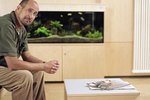Ich is a parasite that is found in nearly all fresh water. Imbalances in your aquarium can set off an ich infestation, where the pests breed rapidly and become a danger to your fish. Combat ich with a combination of clean water and gravel, warm temperatures and a little salt.
The Facts
Ich is the protozoan Ichthyophthirius. It is present in fresh water but does not attack fish until they are sick or stressed. A common cause of an outbreak is a sudden drop in water temperature. When ich attaches to a fish, it produces characteristic white spots--these are protective shells that the organisms produce while they feed on the tissues of the fish. These shells fall off and attach to surfaces in the aquarium, where they go through a reproductive cycle and release free-swimming ich to reinfect other fish (http://www.aquarticles.com/articles/management/Ranson_Ich.html).
While ich is visible on fish, remember that it also goes through its life cycle throughout the tank--in the gravel, on the plants-- everywhere. To prevent reinfestation, the ich has to be controlled not only on the infected fish, but throughout the aquarium.
Considerations

Ich thrives in cooler water. Outbreaks are often triggered when an aquarium heater fails, in combination with substandard water conditions. Since the ich visible on the fish is inside a protective shell, it can't be treated, but since its life cycle is on the order of a few days, the ich will fall off. The trick is to prevent re-infestation.
Some external parasites can be treated with a "dip" in concentrated medication. Use the instructions for the medication as listed by the manufacturer. A typical dip is performed by placing the infested fish in a container with the concentrated medication for about ten seconds, then returning the fish to the aquarium. Reinfestation will occur unless the conditions that caused it are treated--the whole tank has to be considered (http://www.novalek.com/kordon/ridich/index.htm).
Prevention/Solution
The first line of defense is to raise the temperature of your aquarium to 85 degrees Fahrenheit or slightly higher. Next, do a water change of up to 50 percent, washing the detritus off plants and out of the gravel as much as possible. Clean the inside glass and all other surfaces in contact with the water. This should be repeated every day or other day for about a week.
Adding about a tablespoon of salt (Epsom Salts or sea water salt concentrate) per gallon makes the environment worse for ich. If you quarantine a single fish infested with ich, it will not respond to treatment until the cysts fall off as a natural part of their life cycle. Ich infests the gills, so maintain a good level of aeration.
If you use a commercial ich treatment containing formalin, malachite green or methylene blue, the activated carbon in your filter will remove the treatment from the water. Remember to remove the carbon from your filter during treatment. If you have invertebrates in the tank, remove them before treatment or they may die. Methylene blue is an effective treatment for fungal infections--ich is often misdiagnosed as white spots caused by fungal infections. Most manufacturers require treatment to be repeated daily until one to three days after all signs of the ich are gone.




